|
Eythorne

Above photo kindly sent by Glenn Hatfield, showing the original "White
Horse" date unknown. |
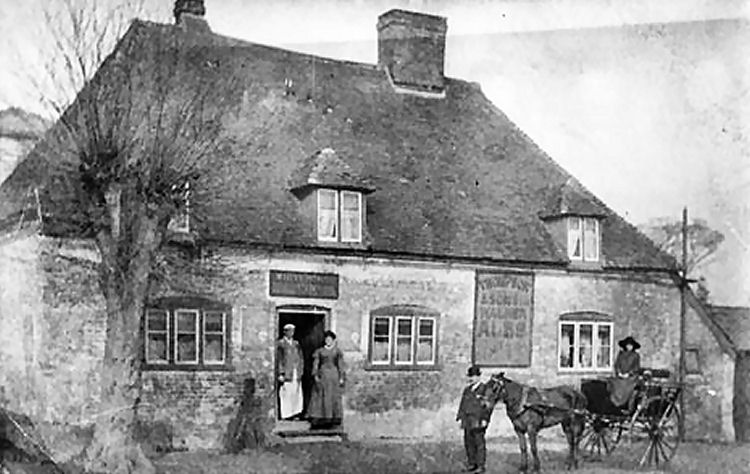
Above picture showing the old White Horse date unknown. |

Above picture showing the old White Horse date unknown. |
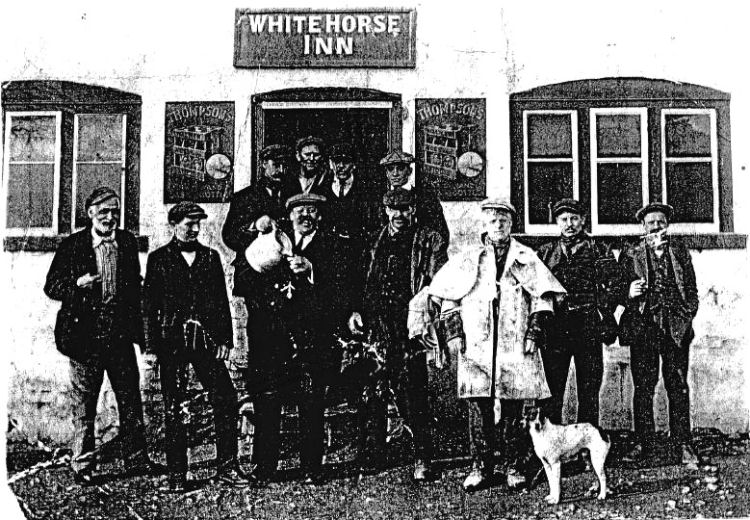
Above photo believed to be the first group of sinkers for Tilmanstone
Colliery circa 1906. Kindly submitted by Colin Varrall. |
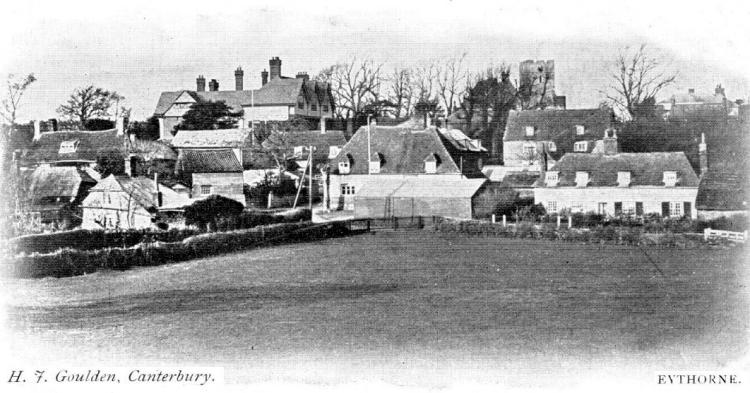
Above postcard, circa 1906, kindly sent by Rory Kehoe. |

Above photo 1952.
Creative Commons Licence. |

Above photo showing the West Street Hunt in 1954. |

Above photo, date unknown. |

Above photo, circa 13 August 1966, kindly sent by Rory Kehoe. No reason
is given for the absence of any signage on this pub which, at the time,
was a Charrington's tied pub. |
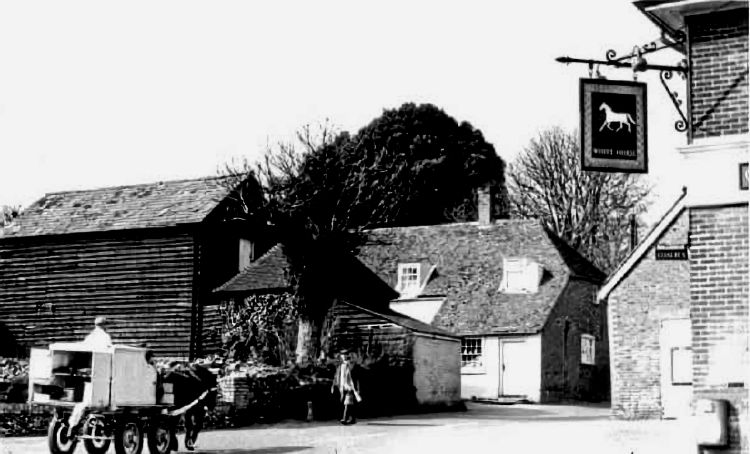
Above photo. date unknown. |
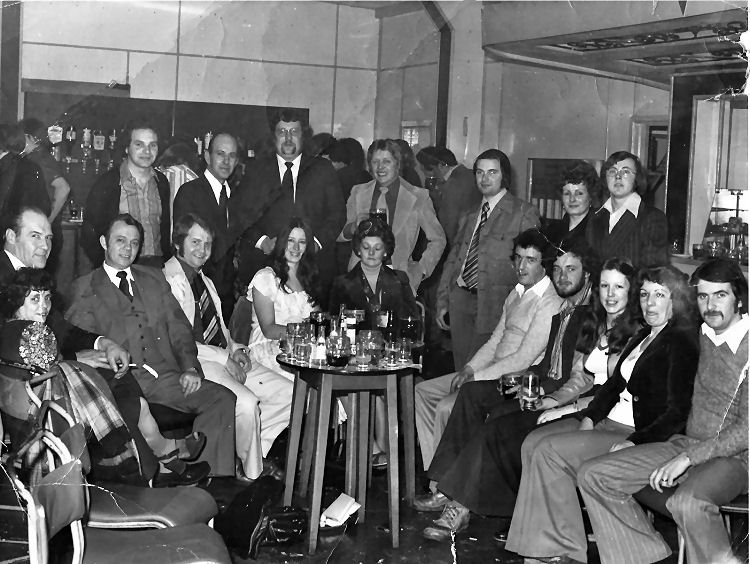
Above photo believed to be taken after a darts match in the 1970s,
kindly submitted by Colin Varrall. |

Thompson & Son ledger.
Creative Commons Licence. |

Above photo, 29 December 1982, by Jim Ashby. |
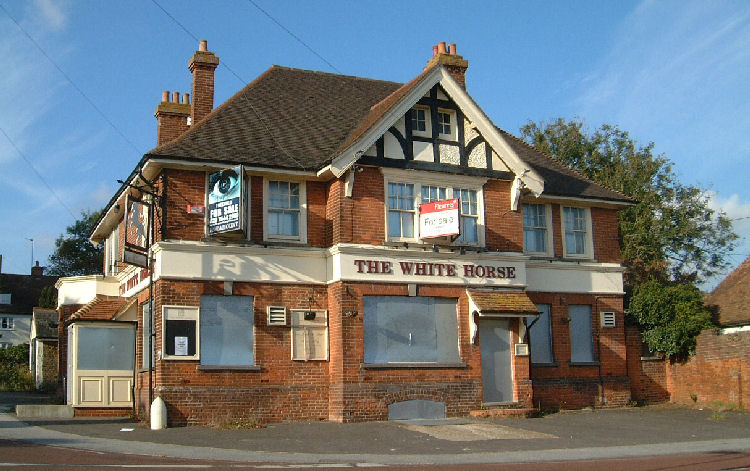
Above photograph by Paul Skelton 27 Oct 2007. |
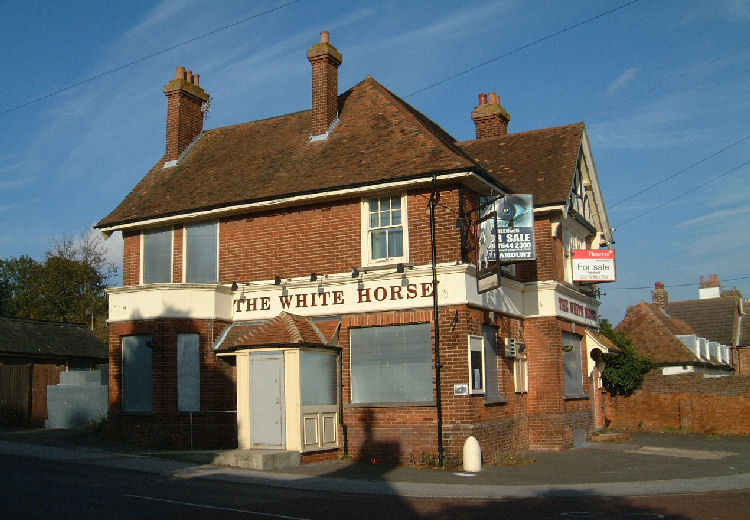
Above photograph by Paul Skelton 27 Oct 2007. |
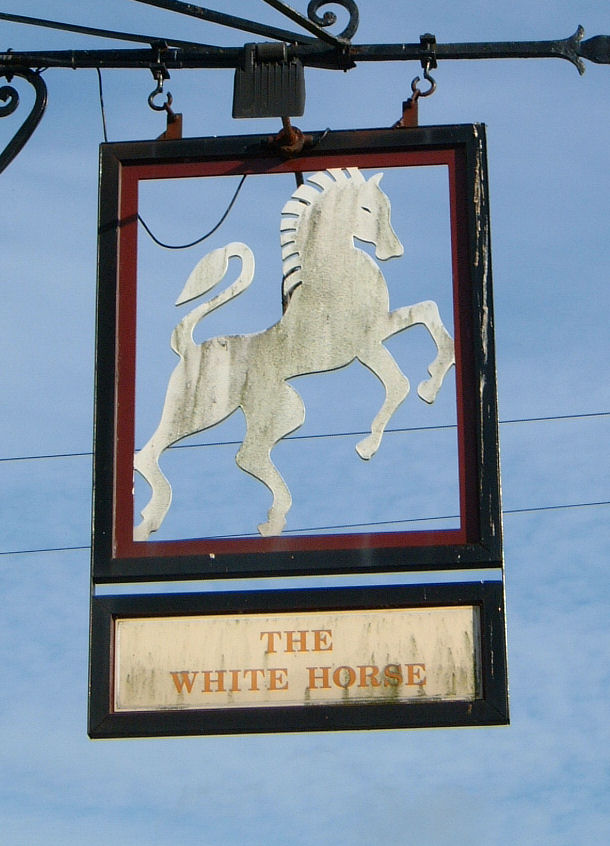 |
|
Above photograph by Paul Skelton 27 Oct 2007. |
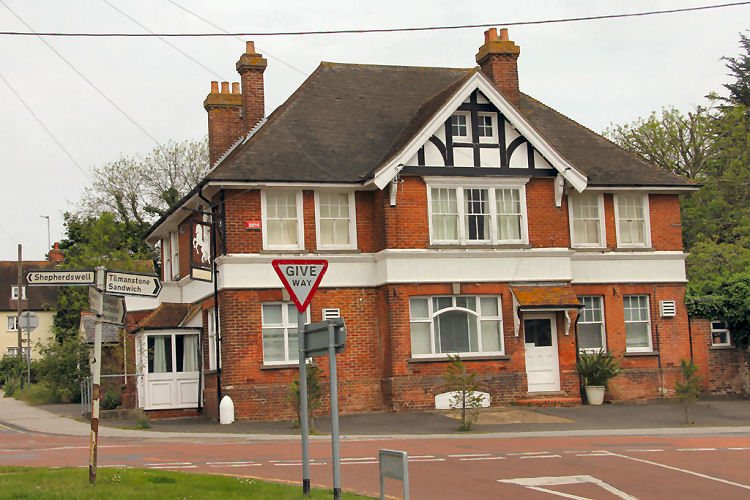
Above photo, May 2014, kindly sent by Erik Hartland. |
Earliest reference found so far is in the Wingham Division Ale Licence
list, which shows the "White Horse," Eythorne, to be re-licensed for the sum of 8 shillings in
1740 indicating that the pub was present before 1740.
It appears to have been tied to a brewery owned by the prominent Sandwich
family, the Wyborns to 1822. In 1764 William Wyborn, brewer, died and his
business was left to his daughter Mary, who had married John Bradley. Their son,
William Wyborn Bradley was born in 1752 William being described as "common
brewer of Sandwich." William was elected Mayor Sandwich in 1785 and died in
1788. The Sandwich brewery and its tied estate of 27 pubs was eventually put up
for "sale by private contract" by William's son (also called William Wyborn
Bradley, born 1779) as advertised in the Kentish Gazette on 10th May 1822.
The pub was sold again along with another 11 public houses in neighbouring
villages in 1826 for the sum of £670 but it is not known from who or to
whom.
Unfortunately now closed for a few years, this pub used to have a skittle
alley in the back garden.
The brickwork, has over time, been scored with the initials of the locals
and regulars.
|
From the Kent Herald, 19 January 1826.
Kent. Freehold and Leasehold Public Houses and other Estates.
At Word, Fingersham, Northbourne, Sutton (next Dover,) Eastry, Tilmanstone,
Eythorne, Frogham, Womenswould, Addison, Barham, Woodnesborough, Goodnestone
(next Wingham,) Ash (next Sandwich,) Shoulden, Walmer, Ramsgate, Margate, Sarr.
St. Peter's, (Thanet) and Sandwich.
For sale by auction, by Pott and Denne.
At the "Bell Inn," in Sandwich, on Monday, the 13th day of February, 1826, at 11
o'clock in the forenoon precisely, (subject to such conditions and restrictions
as will be then and there produced,) the following Freehold and Leasehold Public
Houses and Estate's, in 27 lots, viz:-
Lot 1:- The "Crispin," public house, at Word.
Lot 2:- The "Jolly Gardener," ditto, at Finglesham, in the parish of Northbourne.
Lot 3:- The "Hound and Hare," ditto, at Northbourne.
Lot 4:- The "Star and Boot," ditto, at Sutton (next Dover.)
Lot 5:- The "Bull," ditto, at Eastry, with cottage adjoining.
Lot 6:- The "Three Colts," ditto, at Tilmanstone.
Lot 7:- The "White Horse," ditto, at Eythorne.
Lot 8:- The "Red Lion," ditto, at Frogham.
Lot 9:- The "Rose and Crown," ditto, at Woolwich Green, in the parish of Womanswould.
Lot 10:- The "Bull Head," ditto, at Adisham.
Lot 11:- The "Duke of Cumberland," ditto, at Barham.
Lot 12:- The "Charity," ditto, at Woodnesborough.
Lot 13:- The "Three Crowns," ditto, Goodnestone (next Wingham.)
Lot 14:- The "Admiral Harvey," ditto, at Ramsgate.
Lot 15:- The "Ship," ditto, at Ramsgate, with two small cottages at the back.
Lot 16:- The "Red Lion," ditto, at St. Peter's, (Thanet) with cottage adjoining.
Lot 17:- The "Crown and Thistle," ditto, at St. Peters, Thanet.
Lot 18:- The "Crown," ditto, at Sarr.
Lot 19:- The "King's Head," ditto, in Walmer Road.
Lot 20:- The "Duke of York," ditto, in Walmer Road.
Lot 21:- The "Chequers," ditto, in the Sandhill's, in the parish of Shoulden.
Lot 22:- The "Ship Inn," at Ash next Sandwich with extensive stabling, yard,
Gardens, &c.
Lot 23:- A Dwelling House, near or adjoining the last lot, in the occupation of
Mrs. Maria Green.
Lot 24:- Three Cottages, adjoining the last lot, with the gardens used theirwith,
now in the several occupations of Vincent Noble Kennard, John Harrison, and
Steven Solly.
Lot 25:- All that building and Hop Oast, next or adjoining the last lot now in
the occupation of Mr. Thomas Minter Tomlin
Lot 26:- A Freehold Dwelling House, and Premises, in Church Square, Margate, in
the occupation of William Dale.
Lot 27:- The "New Inn," in Sandwich, with Assembly Room, Theatre, Stables,
Yards, &c.
N.B. Lots 19, 20, and 21, are leasehold, and all the others freehold.
The premises may be viewed on application to the respective tenants, and printed
particulars had (seven days prior to the day of sale) of the auctioneers, and at
the "Bell Inn," Sandwich; "Kings Head Hotel," Canterbury;
"Antwerp Inn" Dover;
"Black Horse Inn," Deal; "Spread Eagle Inn," Ramsgate; "York Hotel," Margate; of
Mr. Benjamin Hall, Solicitor, No. 2, Serjeant's Inn, Fleet Street, London; and
at the offices of Mr. Noakes, Solicitors, Sandwich.
|
|
Sussex Advertiser 20 February 1826.
At the sale of the public houses and other estates, situate in the eastern
parts of the County of Kent, which took place at the "Bell Inn," Sandwich,
on Monday last, Messrs. Pott and Denne knocked down the following lots, at
the sums affixed to them, viz.:—
The "Bull," at Eastry, £1,190.
"Three Colts," Tilmanstone, £500.
"White Horse," Eythorne, £575.
"Red Lion," Frogham, £455.
"Rose and Crown," Womenswould, £166.
"Duke of Cumberland," Barham, £910.
"Charity," Woodnesborough, £710.
"Three Crowns," Goodnestone, £620.
"Admiral Harvey," Ramsgate, £1,150.
"Ship," Ramsgate, £1,250.
"Red Lion," St. Peters, £1,100.
"Crown and Thistle," St. Peters, £705.
"Crown, or Halfway-house," Sarr, £940.
"King's Head," Walmer Road, £425.
The "Duke of York," Walmer Road, £310.
The sale-room was most numerously attended.
We understand that the "Ship," at Ash, and "Crispin," at Worth, have since
been sold by private contract, the former for £750, and the latter for five
hundred guineas.
|
|
Kentish Gazette, 17 March 1857.
KENT LENT ASSIZES.
The commission for the county of Kent was opened on Monday, and
business was proceeded with in both courts on Tuesday morning Mr.
Justice Cresswel presiding on the Civil Side, and Mr. Baron Channell
in the Crown Court.
STEALING AT EYTHORNE.
Michael Clifford, groom, 24, indicted for stealing at Eythorne, a
coat, the property of John Ladd.
Mr. Ladd deposed that he was the landlord of the "Crown Inn" at Eythorne. He knew the prisoner Clifford. On the morning of the 16th
Jan., he left his top coat hanging over a chair in the tap-room. The
prisoner was in the tap-room that morning. The coat was seen safe at
11 o’clock and missed about 1 o’clock, shortly after the prisoner
had left the house. He sent for a constable and they went together
to the "White Horse," in the same village, where they found the
prisoner, he asked him what he had done with his coat, and prisoner
denied all knowledge of it. He gave him into custody. In the
afternoon of the same day the coat was given to him by Mrs. Hogben,
landlady of the "White Horse," who had found it in the back parlour,
hidden under a horse-cloth.
Another witness (a travelling bookseller) deposed to having seen the
prisoner wearing the prosecutor's coat. Prisoner came into the
"White Horse" with it on his back. He went to the back part of the
house and returned without it.
Prisoner said ho took the coat in a mere frolic. He had no intention
whatever to steal it.
Guilty. Six months’ hard labour.
|
|
From the Kentish Gazette, 9 June 1857.
WINGHAM. Petty Sessions. Thursday June 4.
Richard Drake, labourer, and Richard Hogben, landlord of the "White
Horse," Eythorne, were summoned —the first for feloniously stealing
and carrying away two trusses of sanfoin fodder, the property of Mr.
Wm. Harvey, of Elvington Court; and the latter for receiving the
same knowing them to be stolen.
George Stanley Parker, agent to Mr. Harvey, stated that on Thursday
last be was at Eythorne Court, and saw Drake go by with a truss; and
that he traced him to the "White Horse," and inquired of an elderly
female if she knew any thing about the fodder, and was informed she
did not; that he then went into the stable, and there found two
trusses, which he identified to be Mr. Harvey’s property. Witness
said he then gave Drake into custody. Drake said that he had
received orders from the trussers to take the fodder to Hogben’s.
Cross-examined by Mr. Towne:- He ascertained Mr. Hogben was at
Dover, it was about half-past two when he saw Drake go with the
fodder, and he went immediately to Hogben’s. Mr. Wm. Harvey resided
at Elvington Court, and Mr. Thomas Harvey, his brother, at Eythorne
Court; the farms were family concerns, and he supposed William and
Thomas were partners; William generally gave orders, but when he was
not at Eythorne Thomas did.
William Bein said that he and Richard Attwood were the trussers
employed at Eythorne, and he denied that he had given any directions
to Drake to take the fodder.
Richard Attwood confirmed the last witness.
Cross-examined by Mr. Towne:- Mr. Thomas Harvey asked them on
Thursday last to take two trusses to the "White Horse," which he
said he had promised to send, but they declined.
Mr. Towne, on behalf of the parties summoned, commented pointedly on
the impropriety of the charges. He said it was a fact that Thomas
Harvey was addicted to drink, and was doubtless kept without the
means to buy beer; and he would show that he had on the evening
before the fodder was taken been refused credit at the "White
Horse," when he said he would send two trusses, which he did the
following morning. Now, upon the evidence already before the bench,
all this stood admitted, and also that the fodder belonged to
William and Thomas jointly; and clearly it was a most vexatious
charge. He had heard of a gentleman being indicted for stealing his
own corn, and doubtless Thomas Harvey had on this occasion been
abstracting his own fodder. As to Drake saying that the trussers
told him to take the fodder, the bench would see that he merely made
that statement to screen his master from his brother’s anger, and
under the probable fear of being dismissed if he had told the truth;
but he would prove that Thomas Harvey himself had said that he sent
him, and there would be an end of the case.
He then called Mr. Edward Austen, grazier, who was at the "White
Horse" on the evening of the 27th May. Thomas Harvey came into the
parlour, and ordered something to drink, and promised to send two
trusses of fodder in the morning in payment. Mr. Hogben declined to
accept the fodder on these terms. Harvey staid some time after that,
and witness gave him some of his beer, and others did the same.
The bench said they required to hear no more, and dismissed both
charges.
|
|
From the Kentish Chronicle, 14 April, 1860.
WINGHAM PETTY SESSIONS.—Thursday.
(Before Sir B. W. Bridges, Bart., M.P., and W. O. Hammond, and Geo.
Hughes, Esqrs.)
Richard Hogben and George Bye were charged by John Parker with
assaulting him at the "White Horse" public-house, Eythorne, on the 27th
March. The prosecutor deposed that on the day in question he was in the
tap-room at the "White Horse," when the two defendants came in. They
commenced to jeer at and otherwise "aggravate" him. Next they took hold
of him, tore his things on his back, and cut his jacket and trousers.
They pulled him down, rolled him about on the floor, and both of them
kicked him while on the floor.
The defendants called evidence to prove that complainant acted in a very
"aggravating" manner towards them by drinking out of their glasses
without being asked, on which they pushed him out of the room. In doing
this they did not use more violence than was necessary.
The evidence being so conflicting the Bench dismissed the case.
|
|
From the Kentish Chronicle, 16 April, 1864.
ASSAULTING THE POLICE.
William Graham and John Whaley were charged with being drunk and
assaulting a police-constable. The testimony of Sergeant Pope went to
show that on the night of the 25th March the defendants came out of the
“White Horse” public-house at Eythorne, drunk, and commenced fighting;
that on a police-constable interfering, one of the defendants struck him
a blow on the face, and the other in the chest. For the offence of
drunkenness each defendant was committed to gaol for seven days, and
ordered to pay the costs, 8s. with the option of a further seven days
imprisonment in default; and for the assault on the constable a penalty
of 20s. and 10s. costs, or three weeks’ hard labour.
The money was not paid.
|
|
From the Dover Express and East Kent Intelligencer,
8 August, 1879. Price 1d.
A DANGEROUS DOG
Mr. Edward Bromley, of Eythorne, was summoned for not keeping a dog,
of which he was the owner, under proper control.
Mr. Mowll, solicitor of Dover, appeared for the defendant.
It appeared that on the morning of the 31st July, the complainant
(Henry Amos, a baker, also living at Eythorne), was at the "White Horse"
public-house transacting business, having left his horse and cart
outside, a dog, of which he was the owner, being underneath the cart.
Soon after he heard his dog cry out, and on going to the door he saw
defendant's dog holding his dog's hind leg in its mouth. With assistance
he parted the animal, and his dog's leg was found to be broken.
Several witnesses were called, who gave evidence calculated to show
that defendant's dog was a very savage animal, and the Bench informed
Mr. Bromley that he must keep it so as not to be a nuisance, and
directed him to pay the costs of the case, amounting to 21s.
|
|
From the Dover Express and East Kent News, Friday 16 January, 1885.
AWFULLY SUDDEN DEATH
An inquest was held on Thursday week, at the “White Horse Inn,” Eythorne,
by R. M. Mercer Esq., Coroner for East Kent, upon the body of William
Sutton, aged 62, a labourer. Deceased, it appeared, died very suddenly.
On Wednesday, at about noon, he sat down to his dinner with his wife as
usual. He did not talk, and she asked him if he were unwell. He made no
answer, and directly afterwards the knife and fork fell from his grasp.
The wife ran out to get assistance from her neighbours, and Eliza Nash
going in found Sutton sitting in his chair besides the fire quite dead.
A post mortem examination was subsequently made by Mr. William Dixon, of
Shepherdswell, who found that deceased died from an affection of the
heart. The immediate cause of death was syncope from failure of the
heart's action. A verdict of “Natural Death” was returned.
|
|
From the Dover Express and East Kent News, Friday 20 April, 1888.
EYTHORNE
The annual Sparrow Club dinner took place at the “White Horse Inn” on
Saturday last, when about 35 sat down to a hot spread, provided by Host
Chase. After the loyal toast had been drunk, “Success to the Eythorne
Sparrow Club,” which was received with musical honours. Mr. William Gray
was voted to the chair, and Mr. John Blewit to the vice-chair. The
chairman spoke at some length of what good these clubs have done to
farmers in regard to preserving the corn. The Eythorne members have
brought in nearly 2000 during the season, which was received with
cheers. The health of the chairman and vice-chairman was drunk and also
the Host, who responded. After some capital singing, the evening was
brought to a close.
|
|
From the Dover Express and East Kent News, Friday 1 January, 1897. Price 1d.
ALLEGED MURDER AT EYTHORNE
On Christmas Day a terrible horror was brought to light at Eythorne. A
man named Thomas Williams, and a woman who lived with him were drinking
at the “White Horse Inn” on Christmas Eve, and they quarrelled. They
left to go to their cottage at Hickburn not far away, and from the fact
of the groceries which the woman was carrying being strewn about the
road, and there being certain marks of struggling it is supposed the
quarrel was continued on the way home. At two o'clock the next morning
the man called a next door neighbour stating that his wife was dead. It
was found that she was lying in the house dead, cold, stripped of
clothing and covered with bruises. The man's statement was that he had
reached home first and that his wife came home later, wet, and fell in
at the door injuring herself and that he had taken off her clothes
because they were so wet. The man was arrested, and an inquest held
before Mr. R. M. Mercer, County Coroner, in an oast-house at Thornton
Cottages, in the parish of Eastry, on Tuesday. Mr. T. Crofts, foreman,
when the following evidence was taken:-
Ann Taylor, of Hickham, said her husband was a labourer. She had known
the deceased at Hickham, 18 months ago. She went by the name of Mrs.
Williams, and the man Thomas Williams lived with her as her husband. She
only knew her as a neighbour living opposite her, and they were quite
strangers when they came to live at Hickham.
Charles Chase, landlord of the “White Horse,” Lower Eythorne, said: The
deceased has been in my place several times during the last three
months. On December 24 she came into my house about nine o'clock in the
evening, and called for a glass of porter. I served her with it. She
appeared to be perfectly sober. I did not see her again until closing
time, ten o'clock. I saw her go out of the front door and she wished me
“good night” and shook hands with me, and I closed the door after her.
She appeared to be sober. The man Thomas Williams was standing close by
her when I shut the door. I know him as he has been to my house
occasionally, and had been there that evening. I believe he was quite
sober when he left. I knew the deceased as Mrs. Williams.
Albert Percy Dawson, a labourer, living at Ashley, Northbourne, said: On
Thursday night the 24th inst. I saw the man Williams with the deceased
at the “White Horse.” I was there with a man named William Henry
Chapman. I was there from 7.30 until 10 o'clock. Williams and the
deceased came into the tap room together about eight o'clock and stayed
there until ten o'clock. I was in their company and drank with them
until half-past nine and then went into the bar, leaving them in the tap
room. The woman afterwards came out and called for a quart of beer. She
said “I want a quart of beer, and I am going to treat you chaps.” She
was not drunk, but appeared to show signs of drink. Williams came out
and speaking to her said “that is your place in there,” pointing to the
tap room. Previously she had had three quarts of beer, and it was drunk
by those in the tap room. I left at ten o'clock and had not seen the
deceased after the above occurrence. On leaving the house I went across
to Mr. Chase's stables opposite, and stood in the door way. Whilst there
I saw the deceased come out of the house with Williams. Both went away
along the road leading in this direction. It was dark and they passed
out of my sight rather quickly. They were the only people who on leaving
went in that direction. Chapman and myself slept in that stables that
evening. On Christmas Day I left the stables with Chapman shortly before
nine o'clock, and came up the road in this direction. When I saw the
deceased In the Inn she had a parcel, and several smaller ones in the
basket. She said she had got a respectable home now and she had bought
the articles for Christmas. The road up which I came has a bank on
either side of grass, and on one side it is about five feet high. We
could see in one place a woman and a man's footmarks, and where they had
fallen against the high bank. The grass on the bank was pressed down,
and the footmarks were all mixed up together. They were fresh. The place
was about three feet square. Besides it I picked up a pin case produced
and an orange. There were also some currants lying in the road. It was
about nine o'clock when we found these articles. It had been raining
earlier in the morning. On Sunday the 27th I took Instructing Constable
Wall to the spot and helped him to take measurements. On the footpath
leading from the high road to these cottages we found some blue peas and
more currants. There were also signs there on the grass of people having
been stumbling about similar to the marks higher up the road. The
footmarks were not so clear owing to it having been raining.
Henry Morgan, blacksmith, residing near the Church, said: My house is
between the “White Horse” and Thornton Cottages. On the night of the
24th about ten o'clock I went outside on hearing a woman scream. Hearing
nothing more I turned back to go in when I heard a man's voice say, I
think it was “Come along home missus.” I went in and did not hear
anything more.
William Court said: I am a labourer, living next door to the Williams at
Thornton Cottages. I went in my house on the night of the 24th and 25th
inst. I am married, and am also a little deaf. The Williams have been at
the house about six weeks, and I have seen them frequently. About 3.30
on the morning of the 25th inst. I was in bed. Hearing a knock at the
door and afterwards at the window I looked out. Williams was there fully
dressed as he is now with his hat on. He said “Will you get up, my old
woman has come home, she was very wet, and I think she has gone. I told
him I would come down in a minute or two. I got up and dressed and went
down. Williams was standing at my door, and said “Will you come in and
see her.” I went in with him and in the front room on the ground floor I
saw the deceased lying on her back, in front of the fire stark naked,
with a sack thrown over her middle. I went to see and found that she was
dead. Williams said “do you think she has gone.” I replied “Yes I do.”
She appeared to be quite cold. There were no marks of bruising on her
face, or about her at all.
The Coroner: Do you mean to say that? How is it that there are bruises
there now? (Turning to the doctor): I suppose they are not post mortem?
The Doctor: Oh no!
Witness: I see the bruises now, they were not there then. We had a lamp
for a light and Williams held it.
The Coroner: Did you notice the black eye?
Witness: No.
The Coroner: Do you know what a black eye is?
Witness: No sir. (Laughter). I did not see her lip cut, or the bruises
over the left ear.
The Superintendent remarked that the witness had informed the Constable
on Christmas day that he saw the bruises.
Police-constable James Hall, K.C.C., stationed at Tilmanstone said: On
Xmas day about half-past five in the morning William came to my house.
He told me that his wife had just died suddenly. He was a stranger to
me, but telling me where he lived, I arranged to follow him when I had
dressed. I got to his house about seven o'clock. I knocked at the door
and Williams opened it. He took me into the front room and I found the
deceased lying exactly as described by the last witness. I saw she had a
black eye and other bruises, including a bad bruise near the temple, one
on the left hip, and one or two on the breasts. I said “How do you
account for this black eye?” he said, “I do not know, we were together
at the “White Horse,” lower Eythorne last night, and came away from
there at turn out time, ten o'clock. When we got outside the woman ran
away from me, and she had not got these bruises or black eye then. I
came home to my cottage at Thornton, and she came home somewhere between
one and two o'clock. She came to the door, opened it, and fell in. She
was wet through and very cold. She had got some of her clothing on her
arm. I made a fire, undressed and tried to warm her, but she soon died.”
I said to him, “Is she your wife.” He said, “No her name is Agnes Ann
Thompson, and we have been living together about three years.” I asked
him if she spoke after she came into the house. He said she did not, and
he could make nothing of her. I did not arrest him. Williams was in a
very excited state. There was nothing particular about his hands and his
clothing appeared to be in order. I found the woman's clothing in the
back kitchen. It was very dirty and much torn. The clothing was very old
and tattered.
Instructing Constable Stephen Henry Wall, stationed at Eythorne, said:
From instructions received I went to the last witness' house about half
past four on Xmas afternoon, and saw the deceased lying in the same
state as described by the other witness. The basket produced was on the
table in the same condition as it now is. There were several parcels of
grocery in it broken open, and in a dirty condition, and the basket was
crushed in. The spot pointed out by the witness Dawson was 127½ rods
from where the blacksmith lives. There had been a good deal of rain when
I made the measurement, and the footpath could not be seen, but the
grass was still pressed down. There was another place with marks 124½
rods away, and another on the pathway 106 rods distant. At the latter
place a quantity of blue peas, similar to those in the basket, could be
seen.
The witness Court, recalled, said he went to bed about eleven o'clock.
He did not hear Williams or the woman come home.
The Superintendent of the Police said that enquiry had been made at the
surrounding farm houses, and they had not heard anything.
Dr. A. A. McAnnily, of Eastry said that he made a post mortem
examination of the deceased on Sunday morning. The body was that of a
fairly well nourished female, about 30 years of age. There were certain
marks of violence. There was extensive bruising over the left eye, and
on the left side of the head above the ear. There were also bruises o
her hip, extending five inches on the thigh, three bruises over the
region of the liver, and one on the front of the neck, which did not
appear to be so recent. On opening the body he found that there was a
large blood clot under the bruise on the head, and also there was
bruising to be detected, but no fracture of the scull. The right side of
the heart was congested with a dark fluid, and the liver was also
congested. The cause of death was due to the injury to the head,
aggravated by the excessive fatigue he was informed she had undergone.
The Coroner: How do you think that this pressure on the brain caused by
the blood clot was caused?
Witness: probably by direct violence or falling against something.
The witness continuing, said that by direct violence he meant such as
the blow of a fist. The abrasion of the ear was probably caused by
falling, and the laceration of the lips was probably caused by the tooth
of the upper jaw biting down on it. The marks on the hip he thought were
also caused by falling too. He did not think they were caused by a kick.
The injury to the head was the real cause of death, and that might have
been caused by falling over a door step on to the floor. There were no
marks of blood or dirt in the wounds. He should think that the blow on
the head stunned her directly.
The Coroner: Was she a woman such as a man could carry up to the house?
Witness: I should think so.
In reply to a question suggested by the Police, witness said there was a
good deal of mud in the hair, matting it.
The Coroner then told Williams that he could make a statement on oath if
he wished, and cautioned him that there was no necessity for him doing
so, and everything said would be taken down in writing, and might be
used as evidence against him. Williams said he should like to say all he
knew.
Thomas Williams was then sworn and said: I am a labourer and live at
Thornton Cottages, Eastry. The deceased was named Agnes Ann Thompson. I
had been living with her for going on three years. She told me that her
home was in Birkenhead. She said her age was 33. On the 24th we both
left the “White Horse,” Eythorne, about closing time and walked together
as far as the church at the corner. She made the remark, “You do walk
slow, ducky,” and ran off. I did not see any more of her until between
two and three the next morning, when I heard the noise of the door
opening and as if she fell. I came down stairs and found her lying in
front of the fire place on the floor. I found her clothes were wet and
muddy and her little brown bodice was off and lying on the floor. I took
all her clothes off her, and lit the fire and tried to warm her. I could
make nothing of her and went and called my next door neighbour. He came,
and said, “Yes, she is gone,” and put a little bottle of smelling stuff
to her nose. I then went to Tilmanstone and informed the Police about
it. The Policeman told me to go back home and he would come over
shortly. He came over afterwards. That is all I can say about it.
A Juryman enquired if he could ask any questions.
The Coroner: No, not of this man; you can of any other witness.
The Coroner: Do you want an adjournment, Superintendent?
The Superintendent: No, Sir.
The Coroner: What was the charge at Sandwich?
The Superintendent: On suspicion with having caused the death of the
woman. He was brought up on that charge yesterday and remanded in my
custody until tomorrow at ten o'clock.
The Coroner remarked that the only reason for the adjournment was to see
if publicity would bring anything to light.
The Coroner, to the doctor: Do you think it possible to say positively
how the blow was caused?
The Doctor; No, certainly not.
The Coroner asked Williams if he wanted to make any additions to the
statement he had made, about the peas and the marks in the road.
Williams said that he brought those things home; he never saw the woman
after he left at the corner of the road at Eythorne.
The Coroner said that that had heard the evidence, and he was not going
to repeat it, as it would be fresh in their minds. The man leaves with
the woman the public house, both going from that place to the same
destination. The man's story is, he went home alone, the woman followed
and fell in at the door; he came down and found her in this state,
undressed and tried to warm her, but found that nothing could be done.
That is one side; the other is that when the doctor examined her, he
found extensive bruising, and a bruise on the head which in the doctor's
opinion caused death. But it must not be forgotten that the doctor was
unable to say whether it was caused by a direct blow or a fall. That was
an important thing in coming to a decision. There was just the fact,
that the man who is in custody – although, of course, no one in his
custody before a Coroner's Court – had not said a single word with
reference to the state of the basket, or the currants and peas found
along the road, whilst he admits having carried the parcel. The peas and
currents were found at a place where one of the witnesses said he found
the grass trampled down, and it was the extraordinary thing that if the
man did carry the basket, that the ground should be stamped down, not
only on the highway, but on the listway where he went along home, when
he said that she had gone on ahead and he had not seen her until one or
two in the morning. It seemed that it was possible that the woman might
have been carried to the house by the man. These things certainly
amounted to possibilities, and the great difficulty in their way was
when the doctor said, “I cannot say how the bruises were caused, whether
by the fist or a blunt instrument wielded by a man, or by a fall.”
Their duty was, of course, not to act as a Court of trial, but as a
Court of first instance and to place any person on whom they thought
suspicion rested before a Jury to be tried. That was the beginning and
end. They could not put a person on trial against whom there was such
sufficient evidence that a Jury could convict, and it was for them to
say whether they thought that this was a case of suspicion, and that the
man ought to be placed on this trial for wilful murder. If, on the other
hand, they did not think there was sufficient evidence, then he could
only suggest that they should return an open verdict that the deceased
came to her death from an injury to the brain caused by a blow, and that
how and by what means the deceased came by that blow there was not
sufficient evidence to show. It ought to be pointed out that the man
came forward candidly to give the evidence. He had not permitted him to
be cross-examined, because in such cases he never did. It was as easy
for a question to be put, and for a man not sufficiently educated to be
unable tom protect himself.
The cast house was then cleared, and the Jury, after a short
deliberation, returned the following verdict: “That the deceased met her
death from a blow, the manner of which it was caused there not being
sufficient evidence to show.”
|
|
From the Dover Express and East Kent News, Friday 22 January, 1897.
THE EYTHORNE MURDER
The Kent Assizes were opened at Maidstone yesterday by Justice Matthew.
There were two cases from the neighbourhood of Dover – Thomas Williams
on the charge of murdering his paramour at Thornton Cottages, near
Eythorne, on December 25th, and a charge of arson against two labourers
named John James Tyler and Edward John Constant, for feloniously setting
fire to a stack of sanfoin on the grounds of Frederick Prebble and
another at east Langdon. There was also another charge of murder from
St. Lawrence, one of the Liberties of Dover, against Agnes A. Bowers in
respect to her newly-born child on November 25th, 1896.
THE CHARGE
His Lordship, is charging the Grand Jury, of which Sir D. Solomon was
foreman, remarked that, the calendar was in some respects an extremely
heavy one, although there were only a few prisoners – eighteen or
nineteen; but there were no less than three capital charges. There were
two charges against men for murdering in each case the woman he lived
with. The incidents were somewhat of the same character in each case.
Referring to the case against Williams, of Eythorne, he remarked that
there was a greater mystery than in the other case but he thought that
from the evidence they might return a true bill. They left a public
house together, and the next morning the body of the woman was found in
the house where the man lived, dead, lying before a fire. The man's
explanation was that after leaving the public house, the woman ran away,
and came to the house in the early hours of the next morning, wet and
cold. The man said he lit a fire and tried to restore her, but she never
spoke again. Well, that might be, but the suggestion on the other hand
was that he treated the woman with brutal violence. The statement of the
man was that he knew nothing more about the woman after she left him.
The injuries must, however have been done by some one. There was a
witness who heard a scream and the voice of a woman. When the poor
woman's body came to be examined, death was accounted for by the
injuries, and under those circumstances it was their duty to return a
true bill, and let the petty Jury investigate it. He also referred to
the case against the woman Bowers, who was turned out of her house, and
subsequently gave birth to a child, that was afterwards found killed. He
also directed that a true bill be returned in this case.
THE EYTHORNE MURDER
The hearing of this case is fixed for the second to day, and will not be
concluded before evening. There are five new witnesses to be called for
the prosecution.
|
|
From the Dover Express and East Kent News, Friday 29 January, 1897.
KENT ASSIZES
THE EYTHORNE MURDER
At the Kent Assizes held at Maidstone on Saturday before Mr. Judge
Mathew, Thomas Williams, 3rd, labourer, was inducted for the murder of
Agnes Ann Thompson, at Eastry, on the 24th or 25th December, 1896. Mr.
Stuart Sankey and Mr. Talbot appeared for the prosecution on behalf of
the Crown, the prisoner was represented by Mr. Tawell.
Mr. Sankey having detailed at great length the evidence which would be
called.
Albert Percy Dawson, a labourer, of Eythorne, stated that on Christmas
Eve he was in the tap room of the “White Horse.” Williams and a woman
were also there, and at 9 p.m. the latter left the room to order some
beer. Prisoner followed her and ordered her back to the tap-room. At
closing time they left the house together, and went in the direction of
Thornton Cottages, where they lived together. They were about two miles
from the “White Horse.” On the following day he had occasion to pass
along the road by the cottages, and was accompanied by a man named
Chapman. He notices signs of a struggle in the road, there being
distinct traces of the presence of a man and woman there. The grass on
the adjoining bank was beaten down, but the marks were obliterated by a
recent fall of rain. He picked up some currents, an orange, and a pin
case. On the evening of the 27th he accompanied a Constable to the road
and pointed out the spot where he saw the marks, and on the evening of
the 28th, he and the Police officer found some currants and peas near
Thornton Cottage. There were no bruises on the woman's face when she
left the “White Horse.”
Cross-examined: There was nothing in the conduct of the man and woman,
whilst they were in the public house to indicate that they were on bad
terms.
William Henry Chapman, a labourer, gave evidence of a similar character.
William Hall, a thresher, of Eythorne, detailed the action of the
deceased woman and the prisoner in the “White Horse.” He left just
before closing time, and they were apparently on good terms then.
Charles Chase, the landlord of the “White Horse” corroborated, and added
that the prisoner and his companion were apparently sober when they left
his house. Prisoner was then carrying a basket which was filled with
grocery, &c. The woman had no bruises on her face at that time.
Walter Sutton Thorne, grocer and draper, of Eythorne, stated that the
deceased came into his shop on Christmas Eve, when, in change, he gave
her a box of peas, similar to the one produced.
William Webb, assistant to the last witness, said he served deceased on
Christmas Eve with currants, blue peas, and several other articles,
similar to those produced in the basket. Cross-examined – He had not
seen deceased since her death, but knew her from the description which
had since been given him.
Henry Morgan, a blacksmith, living at Church Hill Cottages, Eythorne,
stated that about 10.15 on Christmas Eve he heard some person passing
his house, and going in the direction of Thornton Cottages. He heard a
male voice say “That's all right mussus.” Directly afterwards a woman
screamed loudly. He went out into the road, but it was too dark for him
to see anything. He heard a man's voice exclaim “Come along home
missus,” but he could not say whether it was the same as the one he had
first heard. Cross-examined – he was under the impression that there
were three or four persons in the party, but could not say as he saw no
one.
John Court, living next door to prisoner at Thornton Cottages, said on
Christmas morning prisoner came to him at 3.30, and asked him to come
downstairs as his “old woman had come in wet through, and he believed
she was gone.” He went down and found prisoner standing at his door
fully dressed, and with his hat on. He accompanied prisoner into the
house, and saw deceased lying in front of the fire. She was quite naked,
but had a sack thrown over her middle. She was dead and quite cold. He
did not hear either of them come home on the previous night.
Cross-examined – The fire was alight. He did not notice the man's
clothes or see anything else which attracted his attentions.
P.C. Hall, stationed at Tilmanstone, near Eastry, said prisoner called
him to the house about 5.30 on Xmas day. He saw deceased lying in front
of the kitchen fire, perfectly nude, with an old sack thrown over her.
He examined the body and formed the opinion that she had been dead some
time. Her left eye was blackened, and there was a bruise on the temple
and another on the left hip. He asked the prisoner how he accounted for
her state, and he replied that after they left the “White Horse,” on the
previous night, the woman ran away from him. He went home, and between
one and two o'clock deceased came in. When he opened the door she fell
in, and as she was very wet and cold, he got her into the room and made
a fire. He then took off her clothes and tried to warm her. The bruises
were not on her face when she left him. Some time after she came home
she died. He added that deceased was not his wife, but that they had
lived together about three years. Cross-examined – The statement of
prisoner was quite voluntary. He felt the clothes which he found lying
near the body. They were very tatty and torn, and extremely wet. The
cottage was very poorly furnished, there being nothing in it except two
or three dilapidated chairs, an old table, and a heap of straw.
P.C. Wall, who also went to the cottage, corroborated the evidence of
the last witness as to the condition of the deceased. He saw a basket
standing on the kitchen table which had a number of articles of grocery
in it, all of which were very dirty. Prisoner said he could not account
for the state of the basket, which he himself carried home. On the
following day he examined the road, in company with Dawson, who pointed
out the spot where he had seen marks of a struggle. Nothing was visible
then, butt he weather between Christmas and Boxing Day had been wet.
From this spot to the cottage was a distance of 200 yards. On the 27th
he went to the List Road, a private road leading from the main
thoroughfare to the cottage inhabited by prisoner, and there he found a
quantity of peas and sultanas. Both the roads were used frequently, but
not much at night time.
Supt. Chaney of the Sandwich Division, said he went to Thornton
Cottages, on the 26th December, and saw the deceased lying there as
described by previous witnesses. He found several bruises, and then sent
for a medical man, who examined the body in the presence of witness and
the prisoner. The doctor stated, at the conclusion of the examination,
that he thought the deceased had met her death by violence. Accused made
no reply. Witness then charged him on suspicion of murder of deceased.
To this he replied, “I am innocent. I know nothing about it. She left me
at the corner of Eythorne Church and ran away. I did not see her again
till between two or three in the morning, when she came home to the
house. I came down stairs and found her in the room very wet and dirty,
I lit a fire and undressed her, and I found she was dead. I then called
my next door neighbour up. I brought everything home (including the
grocery). She had nothing, nor any bruises.” Prisoner was then arrested.
On the 27th, in the cells, prisoner said he did not desire to call any
witnesses. He saw no one after he left the public house till he reached
his cottage. He added that when deceased left him she ran towards her
home. Cross-examined – prisoner bore a very good character. He had been
in the Royal West Surrey Regiment for seven years and a few days, and
was discharged with a good record. Prisoner was born at Hearn Bay, and
was an inmate of the Blas Union until he was sixteen years of age.
Dr. McAnnally gave details as to the examination of the deceased's
injuries and the subsequent post mortem. Death was due to concussion of
the brain, following shock consequently on the injuries described, the
clot of blood being especially indicative of serious injury to the
brain. The injuries were either occasioned by a fall or blows either
would account for the whole of the injuries. Deceased was a woman of
slight build standing about 4ft 10in. he was of opinion that
unconsciousness would follow immediately after the infliction of the
injury over the eye. Deceased might have recovered consciousness, and
would then possibly have been able to walk some distance.
Cross-examined: Deceased might have walked home from such a distance as
this where the alleged struggle took place, and then have died on lying
down.
By a Juror: If the woman died at 2 o'clock, it would be impossible for
the body to be cold by half-past three. He should think it would take 24
hours for the body to get perfectly cold.
This closed the evidence for the prosecution, and Mr. Southey, in
summing up the statement of the witnesses, considered that the evidence
pointed conclusively to the fact that the prisoner knocked the woman
down, and afterwards, by some means, got her home, and then did not seek
help until her life had flown.
In an able address for the defence, Mr. Tapsell pointed out that the
evidence against the prisoner was purely circumstantial, and in no
particular was anything which would conclusively convince him with the
information of the injuries from which the woman apparently died. They
left the “White Horse” on amiable terms. The witness Morgan detailed the
hearing of a voice calling on a woman to “come along” home, but added
that the voice was strange to him and that there were probably three or
four persons together at the time. The evidence as to the struggle along
the road was very unreliable. One square foot of grass flattened down on
a bank and a few footmarks in the roadway were held to be evidence of a
“sharp struggle,” but no cast of the footprints was produced, in order
to connect the prisoner with the spot. The doctor's testimony was
conclusive in favour of prisoner's innocence, as he had firmly stated
that all the injuries might have been caused by a fall.
In his summing up, the learned Judge paid a high tribute to the manner
in which Mr. Tassell had, on his request, calculated the case to the
defence. There was not a single topic in his speech which was not
deserving of their considerations. His lordship then dealt with
particular emphasis on the fact that there was not a single item of
evidence which pointed to a motive for the crime. It had been alleged
that prisoner was jealous of the woman, but nothing was adduced in
support of this allegation. He laid particular stress on the fact that
prisoner remained on the spot, and even invited the Police to his
cottage. Considering these points, he ruled that the evidence was not
sufficiently strong to warrant the Jury finding the prisoner guilty of
the capital charge. As to the second count, that of manslaughter, he
pointed out that the evidence was more conclusive. The prisoner himself
stated that he carried home the basket, and several articles, which were
picked up by two of the witnesses, corresponded with the goods bought by
deceased. The witnesses in question also gave evidence as to the marks
of a struggle in the road, which proved that a man and woman had been
together there, and that a heavy body had pressed down the grass on the
bank. He thought the evidence pointed to the deceased having been
knocked down, because she was admittedly sober, and there was nothing to
cause her to fall.
The Jury returned a verdict of “Not Guilty,” as both doubts, and
prisoner was accordingly discharged.
|
|
From the last will and testament of Henry Edward Davies, 5 May 1914.
This is the last will and testament of Henry Edward Davies of the
"White Horse Inn," Eythorne, near Dover, in the county of Kent, licenced
victualler.
I direct all my joint debts, funeral and testamentary expenses to be
paid and fully satisfied as soon after my death as conveniently
manageable and subject thereto I give divine and legislate all my state
and effects of everything whatsoever on to my wife Sarah Elizabeth Young
Davies, for her own use and benefit absolutely, whom I appoint sole
executrix of this, my will and hereby revoking and making void all
former and other wills by me at any time heretofore made legally declare
this to be my last will and testament in witness whereof the total on
have testament set my my hands this 5th day of May 1914. Signed by
the above named Henry Edward Davis as his last will in the presence of
witnesses being present at the same time, who to in his presence and in
the presence of each other have hereunto satisfied our names to witness.
George Dye,
Sydenham Payne, solicitor.
14 Branch Street, Dover.
Henry Edward Davis
On the 29th day of June 1918 probate of this will was granted at
Canterbury to Sarah Elizabeth Young Davies widow the sole execututrix.
|
|
From the Dover Express and East Kent News, 15 January 1954.
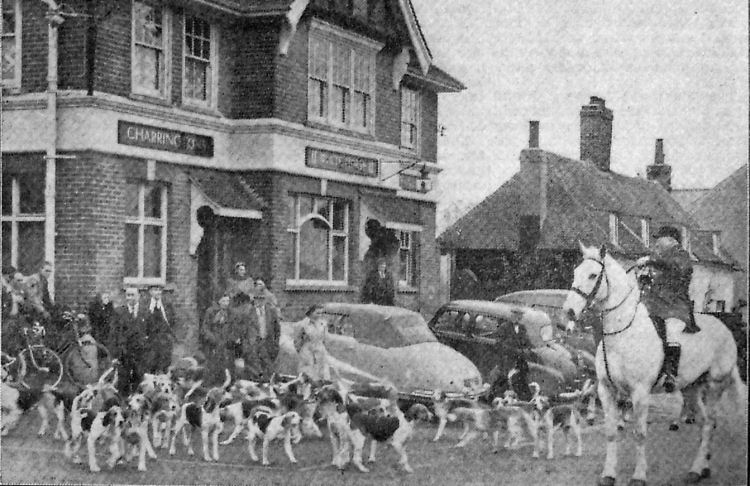
MET AT THE "WHITE HORSE"
What better meeting place for the West Street Hunt, under their Master, Mr. A. J. Stevens, on his white horse,
than the "White Horse" Inn, at Eythorne? A large field of riders, on
Tuesday, enjoyed a good day's sport.
|
|
From an email received 5 December, 2011.
Dear Sirs,
Regarding the "White Horse Inn" at Eythorne I have some information
to add regarding my family occupation of the pub in the 1950s.
My father William Frederick Lloyd moved together with his wife
Lillian Lloyd and myself Alan Lloyd from the "Prince of Denmark" in
Junction Road Islington London in 1950 approx., to the "White Horse"
and was the licensee until approx 1957. He then took the licence of "The
Holly Tree" pub in Hither Green, London,
until he died in approx 1961. My mother survived until her death on the
Isle of Wight approx 8 years ago.
My father and mother are in the picture of the hunt featured in your
website. He is in amongst the hounds with a
dark suit and my mother is wearing a light raincoat next to the
convertible Austin Cambridge.
I remember him offering Mr Stevens the traditional stirrup cup on that day.
I was age 17 and worked for the firm of accountants Clemetson Stanford
of Dover and was a friend of
Stan Wells the well known reporter and later editor of the Dover
Express. We sometimes toured other villages
challenging the customers to a darts match. (no problems with drinking
and driving then.)
Many of our customers were workers, invalids or recovering injured from Timanstone Colliery.
Although well paid the miners were always in danger of injury or lung
damage. Many families originated
in the North and brought their love of whippets, pigeons and dominoes
with them. A favourite joke was to
play blind dominoes. This involved playing the dominoes face down
without seeing the spots and usually
started when a stranger was in the bar and ended with a free drink. (The
secret was signalling with the
feet under the table while keeping straight faces.) Traditional food
from the bar involved cheese and pickle,
pickled eggs and pigs trotters, (the trotters made an awful mess.)
I left Eythorne for my National Service mainly spent as a radar operator
on the Isle of Wight where we sometimes
launched fighter planes from mainland airports to intercept possible
bomber threats from Russia. The cold war was well entrenched at that time.
Since then I have spent 55 years here on the island and have owned
hotels, worked as an estate agent and finally
managing director of a travel company featuring remote and exotic
destinations ('Regent Holidays' now based in Bristol).
Currently I live on the seafront at Sandown but spend half my time in
Southern Spain.
Best regards,
Alan Lloyd.
|
|
From the Dover Express and East Kent News. 26 April, 1963.
Seventy Years Young.
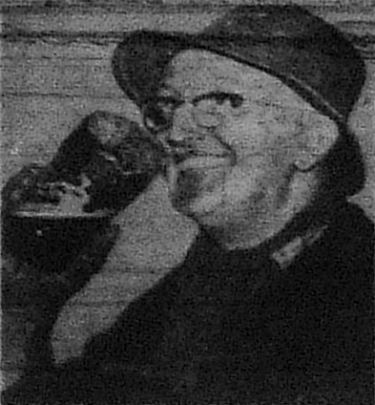
Meet a sprightly 70-year-old who spends his working day humping
hundredweight sacks of coal around because he reckons it keeps him
young.
Pictured taking his daily "pinta" at the "White Horse," Eythorne, the
other day is Mr. Albert Friend, the Shepherdswell coal merchant, who has
been delivering coal in the district for almost 45 years.
Known affectionately as "Tar," Albert founded his business after the
first world war, with a horse and cart.
During his years "Tar" has also dabbled in other enterprises.
Between the wars he ran a scavenging business and built an
incinerator at Tye Wood, just outside Elvington, which locals still call
"Friendies Tip."
"The Council stopped it being used in 1936 because they thought it
was out of date or something, but I think my old furnace could still
solve a lot of our refuse problems," he says.
And how's this as a proud boast! "Tar" says he still gets up at 5.30
every morning and - Sundays as well - can still keep up with his sons
when it comes to humping sacks.
|
|
From the Dover Express and East Kent News. 7 June, 1963.
Licensee Leaving.
After four years and two months, in what he calls, "one of the nicest
little villages in the whole of Kent," 50 year old Mr. Reg Biggs,
popular licensee of the "White Horse" public house, isleaving.
With his wife and 12-year-old daughter, Gillian, he moved to Eythorne
from London, where he was employed as a maintenance engineer in a
factory which produced scientific instruments.
The Brewery have named Mr. John Hibbitt, formerly of Hastings, as Mr.
Biggs successor, but his appointment is subject to the Justices
Approval. If all goes well he will take over at the end o the month.
|
|
From the Dover Express and East Kent News. 22 January, 1971.
NEW LICENSEE AT HORSE
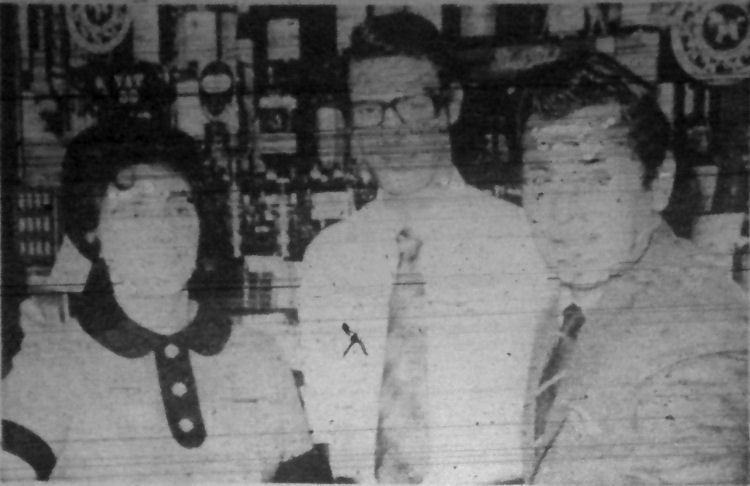
Mine hosts at the "White Horse," Eythorne, Mrs. Patricia Chandler,
son Roger and landlord Mr. Valentine Chandler.
Though wellknown in Aylesham and Sandwich - and born and bred in
Littlestone - Mr. Valentine Chandler had never been to Eythorne before
he took over as landlord at the "White Horse." All the more odd because
his brother works at Tilmanstone Colliery, less than a mile down the
road.
It was a long while since Eythorne had a gardening society for the
soil does not encourage exhibition growers.
But if anyone can coax blooms out of the garden at the "White Horse"
it will be Val who has taken the sweet-pea cup at Aylesham for the last
three years and also the Astor cup at Sandwich three times in a row.
A man who likes getting on with things, even he was surprised when
he was offered a pub only a fortnight after lodging his credentials with
the brewers. He is at present a site agent with a commercial company
working on the A2 improvements.
It will be a truly family venture. One of the keenest on a pub idea
is Val's 21-year-ols son Roger.
|
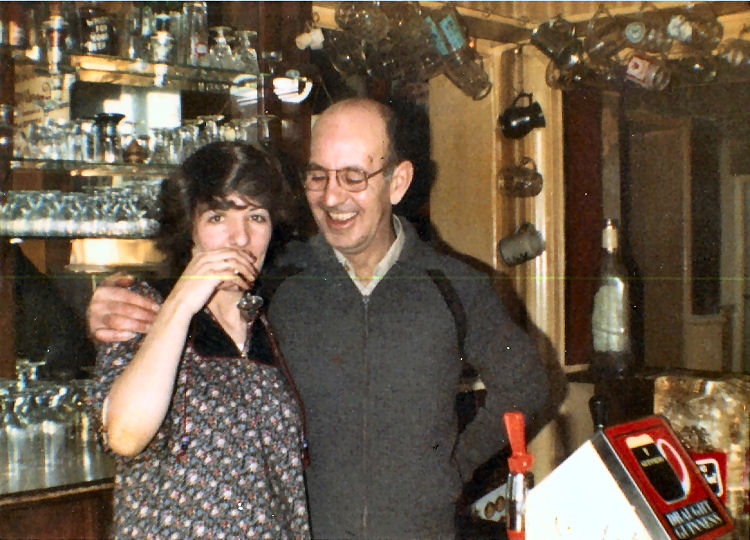
Licensee and daughter, date unknown. Kindly sent by Colin Varrall. |

Above photo showing the licensee, name and date as yet unknown. Kindly
submitted by Colin Varall. |
Latest news heard January 2015, a planning application has been submitted for a
change of use to a bed and breakfast and restaurant.
|
From the Dover Express, 8 January 2015.
B&B planned for old pub.
RIPPLE: The former White Horse public house at Eythorne, converted into
residential accommodation, is likely to be . welcoming guests again, but
as a bistro-style cafe-restaurant, not a pub.
Chef Mark Stallard, of Beach Street, Deal, plans to convert the
five-bedroom property, in Church Hill, into a bed and breakfast guest
house, using only three of the bedrooms for guests.
He wants to retain one of the others for himself.
In addition, his plans include a licensed restaurant with ten tables
offering breakfast, lunches and dinners.
The property, according to his planning application belonging to Susan
Burrow, of Deal, has been empty since December.
|
The area of land that used to be the skittle alley and also car park, I am
informed has been retained by the former owners Admiral Taverns, and although
the current owners put in a bid for the land for their own garden and kept it
nice for a few years, their offer was refused. The area is now overgrown and
Admiral Taverns seem to have lost interest in any development or passing it over
to the current occupants.
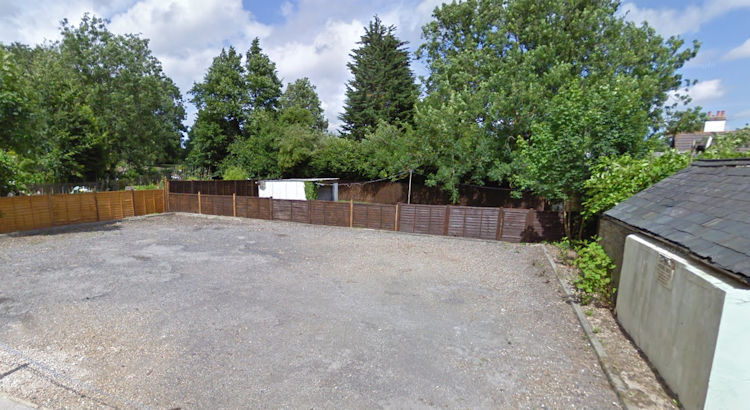
Above Google image, July 2009, showing the skittle alley at the back
of the pub. |

Above Google image, May 2021. House called Majubi House. |
LICENSEE LIST
HUDSON Henry 1740+

HOGBEN William 1841-47+
 (also farmer age 50 in 1841
(also farmer age 50 in 1841 ) )
HOGBEN Richard
 1851-58+ (age 26 in 1851 1851-58+ (age 26 in 1851 ) )
HIGGENS Joseph 1859+
PARKER John 1860+
NORRIS Edmund 1866-74+

CHASE Charles 1878-Nov/1910 (age 34 in 1881 ) )
    
GEORGE Thomas S Nov/1910-11+ (age 30 in 1911 ) )

 DAVIES Henry Edward 1913-July/18 dec'd
DAVIES Henry Edward 1913-July/18 dec'd
 
DAVIES Sarah Elizabeth Young (widow) July/1918+

PRITCHARD Emily Louisa to Jan/1921

HARRISON William Jan/1921+

DAVIES Sarah Mrs 1930-38+

PARKER Archibald to Sept/1940

BRAILSFORD Mr C Sept/1940-Oct/40

TERRY Mrs E J Oct/1940

 GINN Mr G R Oct/1940-May/43
GINN Mr G R Oct/1940-May/43

PLUMMER Arthur J May/1943+

TALMAGE Gerald T to Sept/1950

PAYNE George H 13/July/1950-53+

LLOYD William Frederick 1953-55
LEVER W G 1955-57
COLLINS-BATCH L 1957-Apr/59
BIGGS Reg S Apr/1959-Jun/1963

HIBBITT Mr John Jul/1963-Oct/66

BULLEY E H Oct/1966+
CHANDLER Valentine & Pat 1971+

JONES Arthur 1974+
 Charrington & Co
Charrington & Co
https://pubwiki.co.uk/WhiteHorse.shtml
http://www.closedpubs.co.uk/whitehorse.html
The Dover Express reported that T S George was formally a farmer from
near Faversham.
 From Wingham Division Ale Licences 1740 Ref: KAO - QRLV 3/1 From Wingham Division Ale Licences 1740 Ref: KAO - QRLV 3/1
 From
Bagshaw Directory 1847 From
Bagshaw Directory 1847
 From the Post Office Directory 1874 From the Post Office Directory 1874
 From the Post Office Directory 1882 From the Post Office Directory 1882
 From
the Kelly's Directory 1899 From
the Kelly's Directory 1899
 From the Post Office Directory 1901 From the Post Office Directory 1901
 From the Kelly's Directory 1903 From the Kelly's Directory 1903
 From the Post Office Directory 1913 From the Post Office Directory 1913
 From the Post Office Directory 1914 From the Post Office Directory 1914
 From
the Kelly's Directory 1934 From
the Kelly's Directory 1934
 Library archives 1974 Library archives 1974
 From the Dover Express From the Dover Express
|























